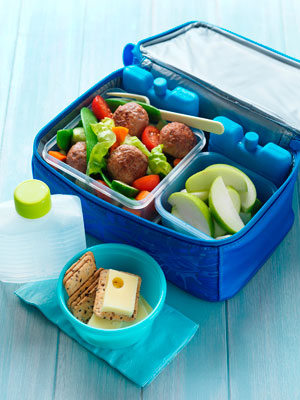Plan a Nutrition Punch in the School Lunch

Plan a Nutrition Punch in the School Lunch
Packing nutritious foods for school lunch will help kids stay active and help with concentration and learning throughout the day. Foods such as red meat, wholegrain foods, vegetables, fruit and dairy foods provide key nutrients, such as protein, iron and zinc, calcium, omega-3 and B vitamins, required for good health in busy kids.Low levels of iron and zinc can contribute to tiredness, lethargy, difficulty in concentrating and being more prone to infection.
Accredited practicing dietician, and mother of two school aged children, Kate Di Prima provides some tips and tricks on how to pack a healthy lunch for the kids that will get eaten… and enjoyed.
"Lunch is one of the most important meals for school age kids, and it often comes home untouched. With a bit of forethought and planning, a nutritious and appealing lunch box can be very quick and easy to prepare.
The following tips on what to pack and how to ensure it gets eaten will help kids perform at their best this year."
Lunch Box Essentials - 5 + Water
1. Protein-rich food (trimmed meat, fish, egg or legumes) provides protein power to keep children satisfied longer as well as key nutrients such as iron, zinc, omega-3 and B vitamins. Red meat, such as beef and lamb, are good sources of iron and zinc. Add to salads, pasta or as sandwich fillings.
2. Fresh fruit for vitamins and fibre.
3. Dairy or soy (cheese, milk or yoghurt) for calcium and protein.
4. Vegetables for antioxidants and fibre.
5. Grain-based food (wholegrain bread or crackers, rice or pasta) for fibre and slow release energy.
Plus Water - it's the only drink kids need.
Hints and Tips to Ensure Lunch Gets Eaten
As a mother of two, Kate is very aware of the frustrations around a power-packed lunch returning uneaten. Kate shares some of her best tips below:
Keep it interesting
Vary foods from day to day.
Experiment with different tastes, textures and colours - have a trial at home so kids are familiar with new foods.
Make it accessible
Chose an appropriately sized insulated lunch box which opens easily and stays cool.
Avoid too many choices, particularly "treats".
For smaller children and those starting school, use coloured dots or star stickers to identify recess and lunch and to identify which foods to eat first
Make it easy to eat
Kids like kid sized portions that fit easily into small hands - use small dinner rolls or just one piece of bread in sandwiches to ensure lunch looks manageable.
Don't overfill sandwiches.
Use small pieces of fruit or chop into bite-sized pieces (squeeze over some lemon juice to avoid browning).
Match their routine
If your child has recess late, swap lunch foods with recess foods. By 11.30am most children will be starving and a protein rich food will help best sustain them for the rest of the day.
Food safety tips
Freeze a low fat milk drink, low fat yoghurt tub or freeze fruit cubes - along with an ice brick - to keep contents chilled.
Make sandwiches, muffins, scrolls etc a week ahead and freeze. They will be deliciously fresh at lunchtime and will help keep contents cold.
Invest in an insulated lunch box - with a zip for small hands to open easily.
Keep food fresh and protected in reusable hard plastic containers.
Make it Easy for You
Leftovers make great lunches the next day and add variety to the menu. For example:
Use leftover roast to make sandwiches and bolognaise sauce make great wraps sprinkled with cheese or taco mince made into burritos.
Meals like fried rice and even some stir fries are appetizing cold.
Add leftover meatballs, cutlets or sliced steak with cut-up raw vegetables such as carrot and celery sticks; snow peas and cherry tomatoes.
For schools with microwaves, pack leftover pasta meals such as spaghetti bolognaise or lasagne.
Plan Ahead
This year, break the lunch box rut and plan to pack some serious nutrition into the school lunch with Kate Di Prima's easy 5-day plan:
 For more information visit www.themainmeal.com.au
For more information visit www.themainmeal.com.auMORE



